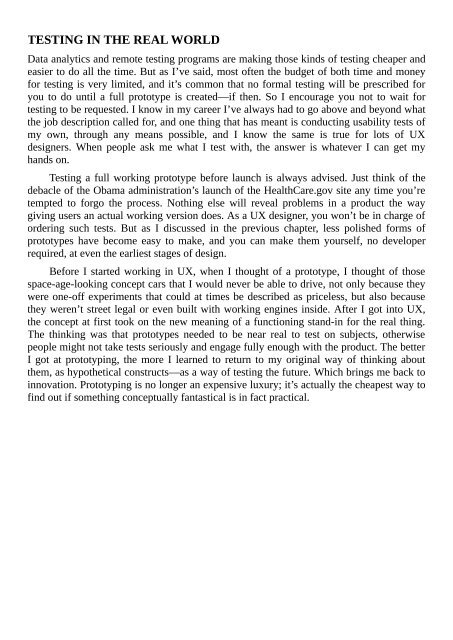Create successful ePaper yourself
Turn your PDF publications into a flip-book with our unique Google optimized e-Paper software.
TESTING IN THE REAL WORLD<br />
Data analytics and remote testing programs are making those kinds of testing cheaper and<br />
easier to do all the time. But as I’ve said, most often the budget of both time and money<br />
for testing is very limited, and it’s common that no formal testing will be prescribed for<br />
you to do until a full prototype is created—if then. So I encourage you not to wait for<br />
testing to be requested. I know in my career I’ve always had to go above and beyond what<br />
the job description called for, and one thing that has meant is conducting usability tests of<br />
my own, through any means possible, and I know the same is true for lots of UX<br />
designers. When people ask me what I test with, the answer is whatever I can get my<br />
hands on.<br />
Testing a full working prototype before launch is always advised. Just think of the<br />
debacle of the Obama administration’s launch of the HealthCare.gov site any time you’re<br />
tempted to forgo the process. Nothing else will reveal problems in a product the way<br />
giving users an actual working version does. As a UX designer, you won’t be in charge of<br />
ordering such tests. But as I discussed in the previous chapter, less polished forms of<br />
prototypes have become easy to make, and you can make them yourself, no developer<br />
required, at even the earliest stages of design.<br />
Before I started working in UX, when I thought of a prototype, I thought of those<br />
space-age-looking concept cars that I would never be able to drive, not only because they<br />
were one-off experiments that could at times be described as priceless, but also because<br />
they weren’t street legal or even built with working engines inside. After I got into UX,<br />
the concept at first took on the new meaning of a functioning stand-in for the real thing.<br />
The thinking was that prototypes needed to be near real to test on subjects, otherwise<br />
people might not take tests seriously and engage fully enough with the product. The better<br />
I got at prototyping, the more I learned to return to my original way of thinking about<br />
them, as hypothetical constructs—as a way of testing the future. Which brings me back to<br />
innovation. Prototyping is no longer an expensive luxury; it’s actually the cheapest way to<br />
find out if something conceptually fantastical is in fact practical.


